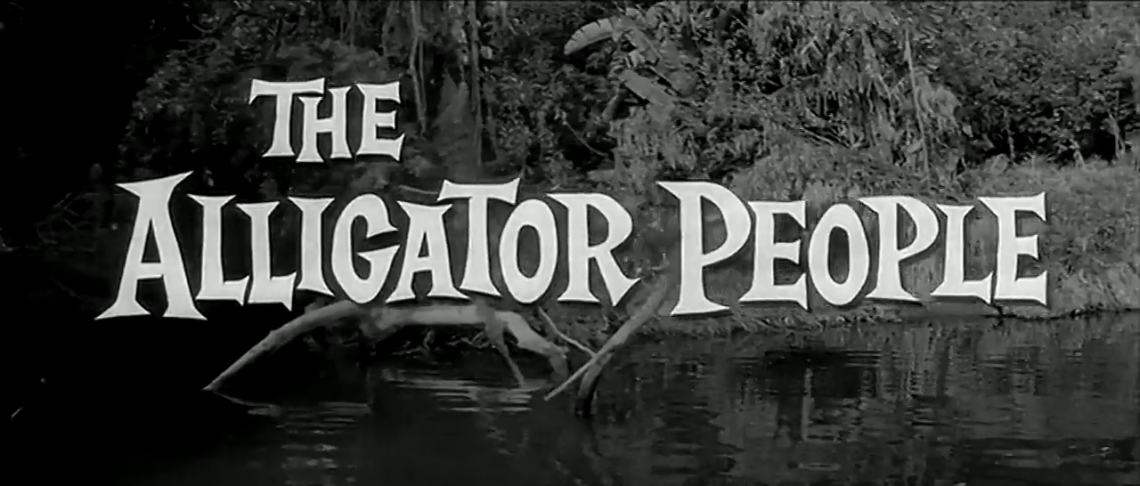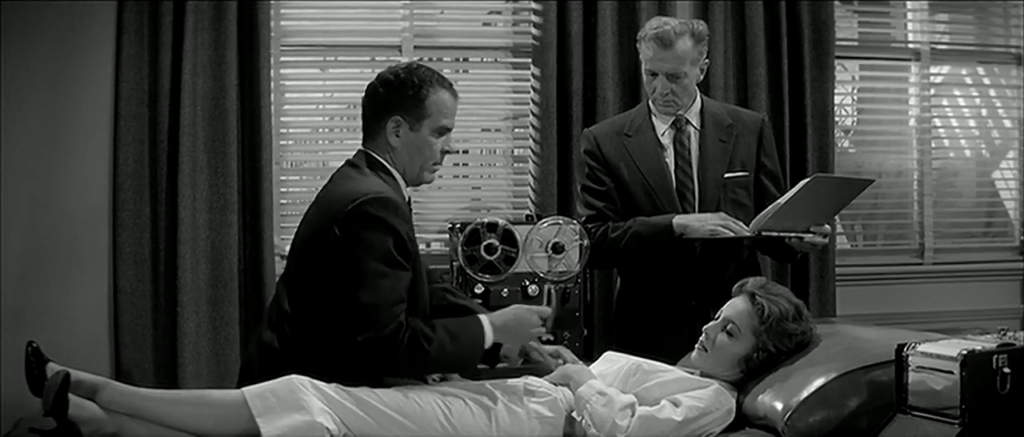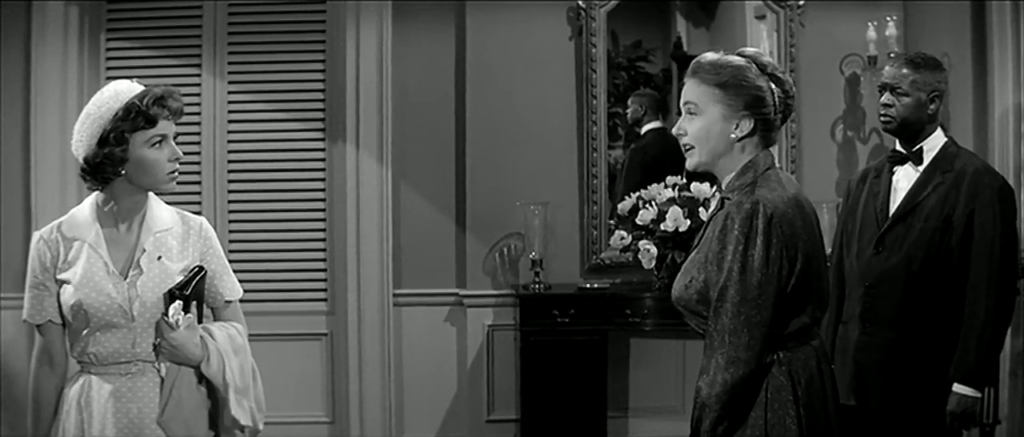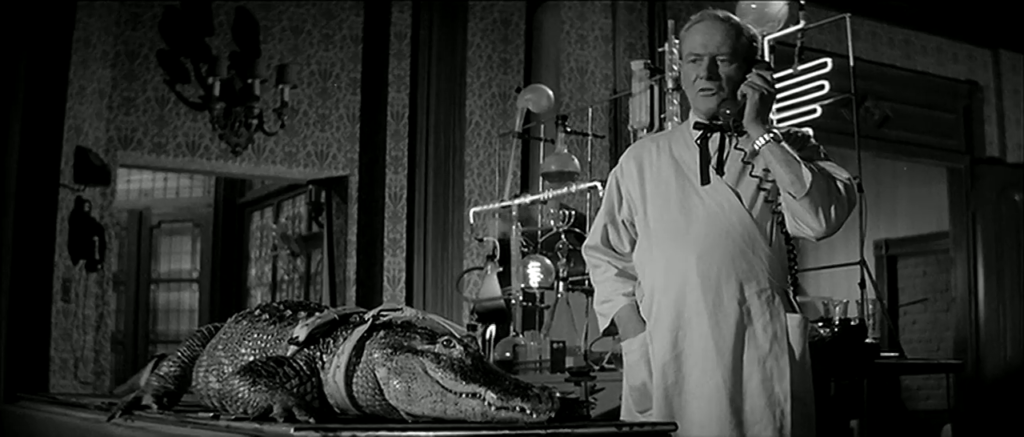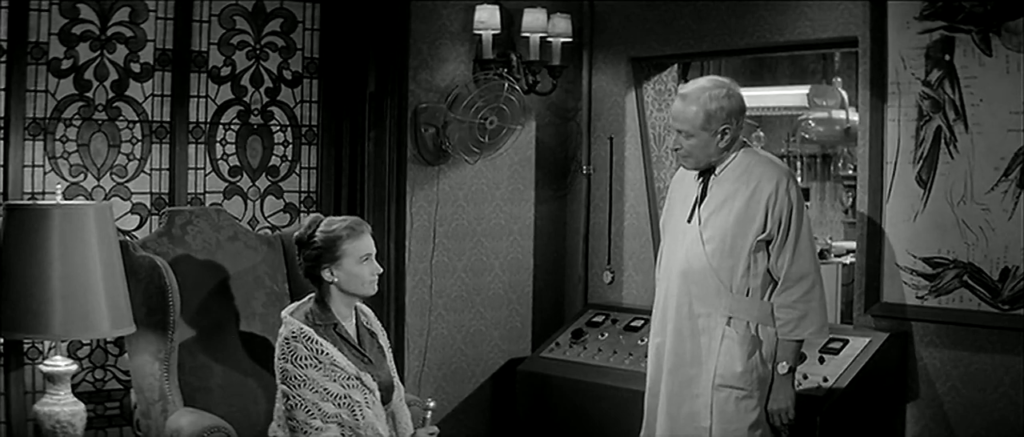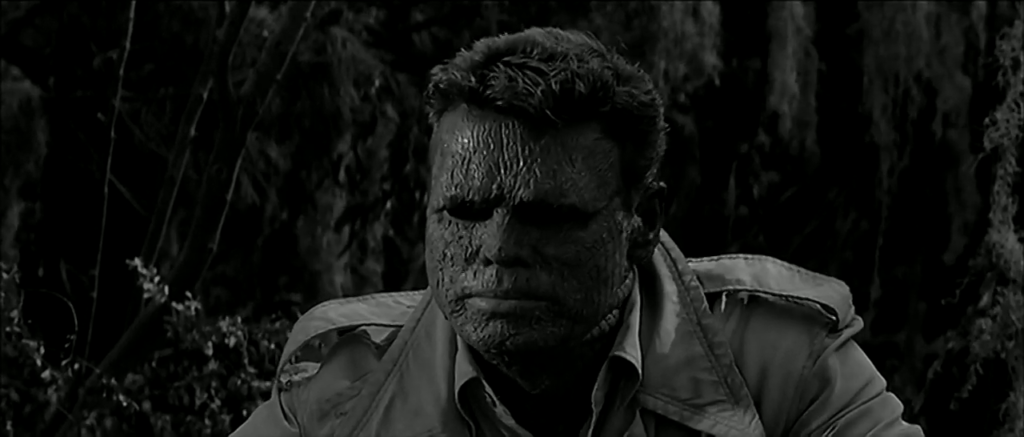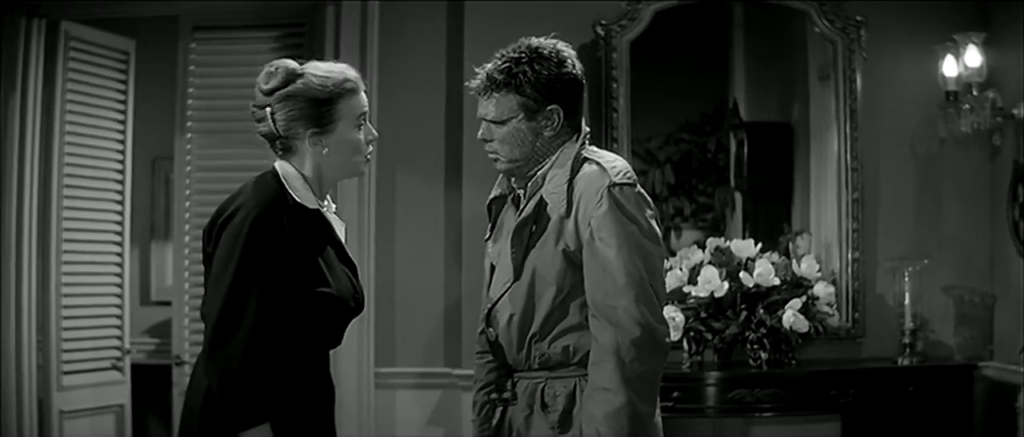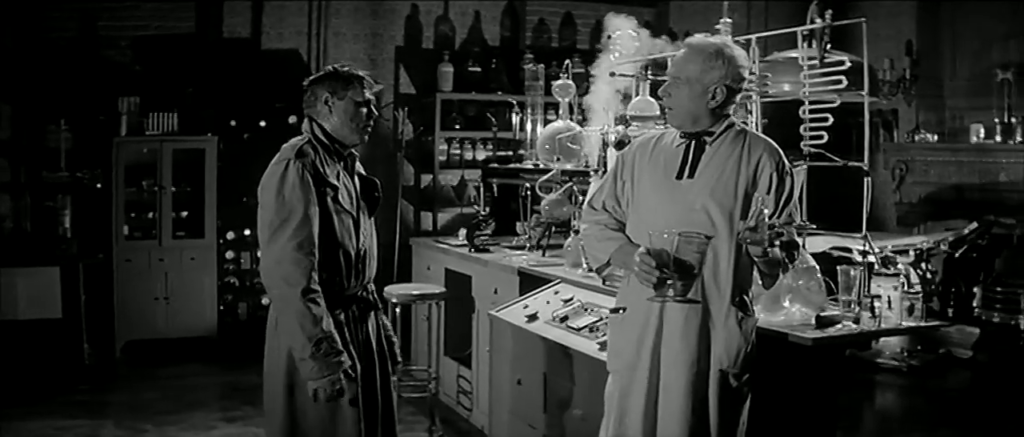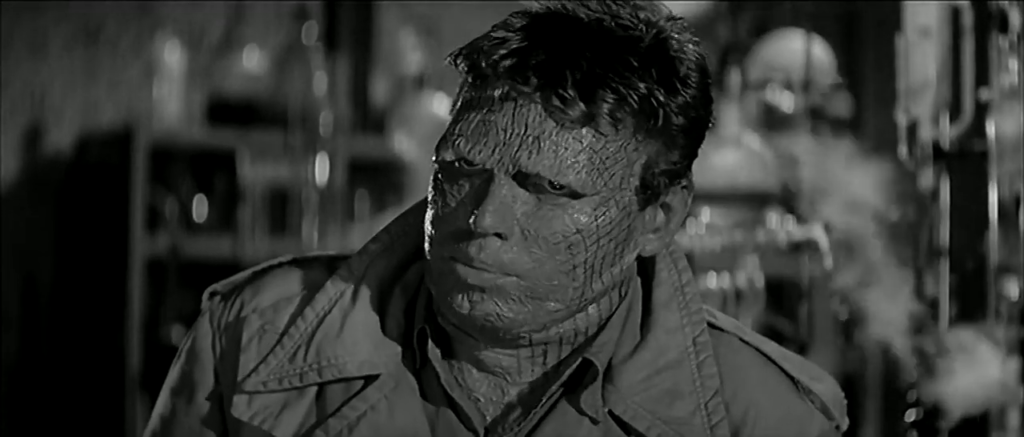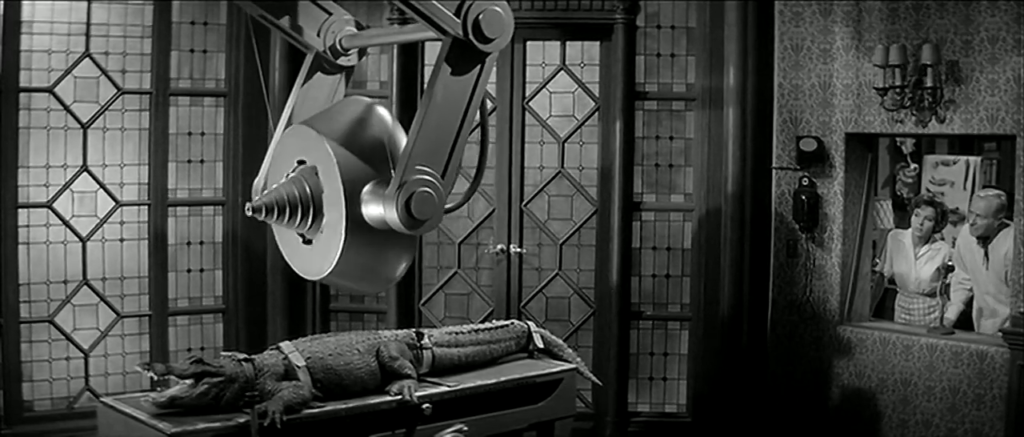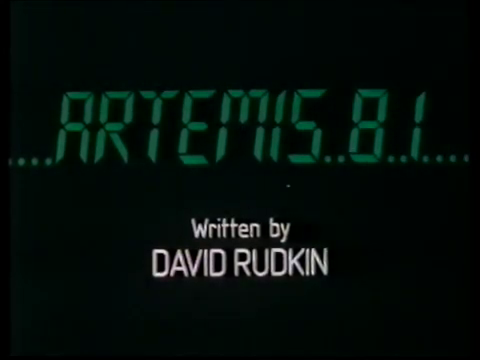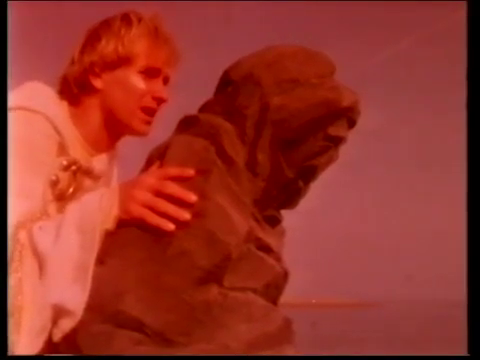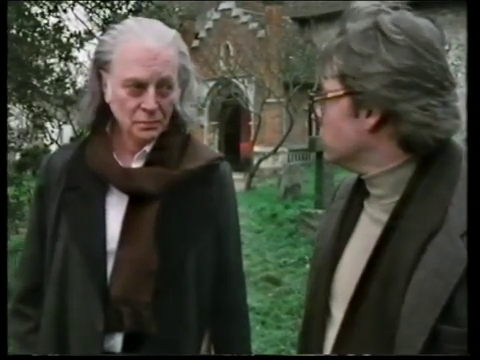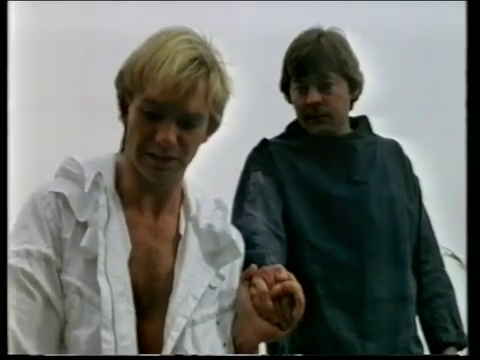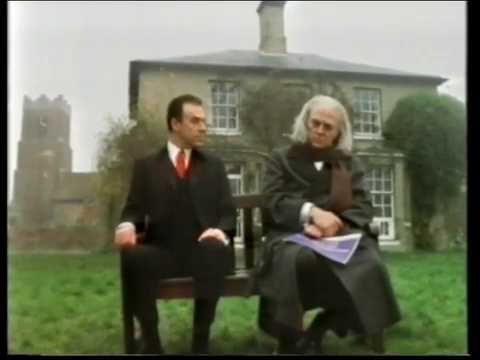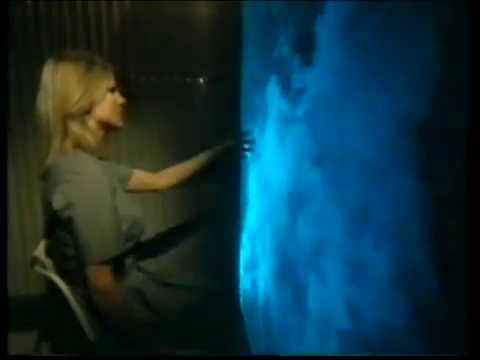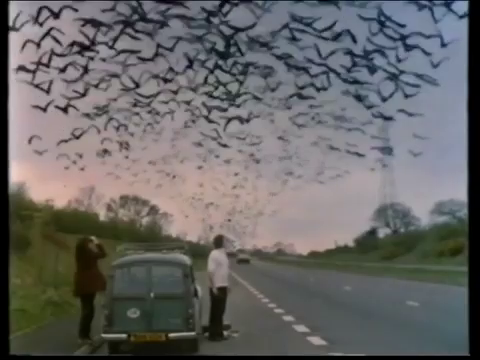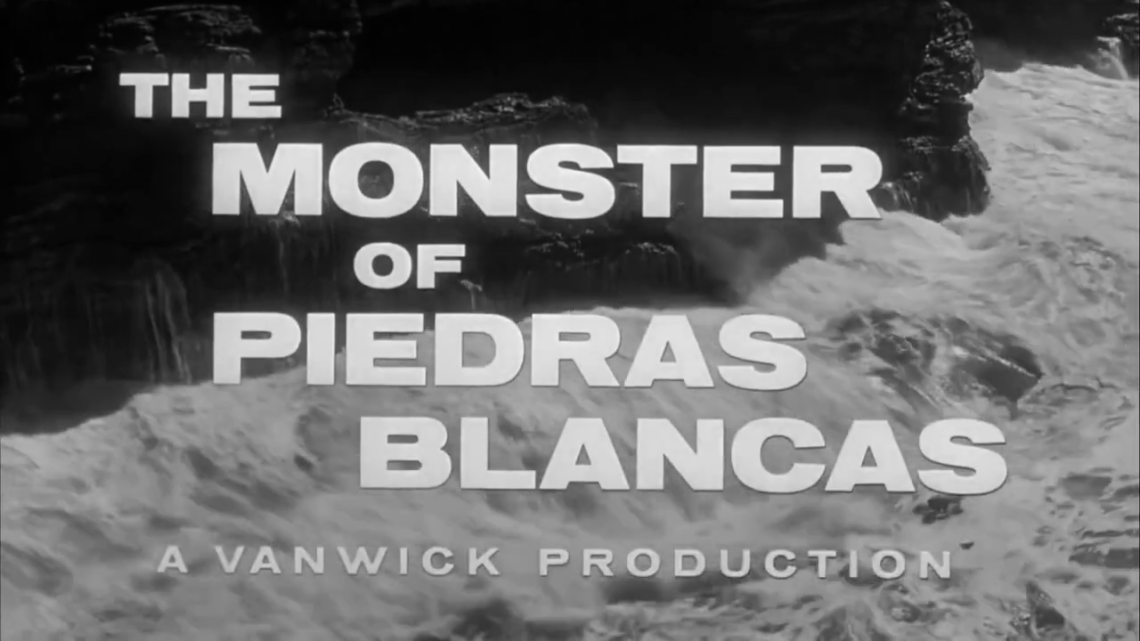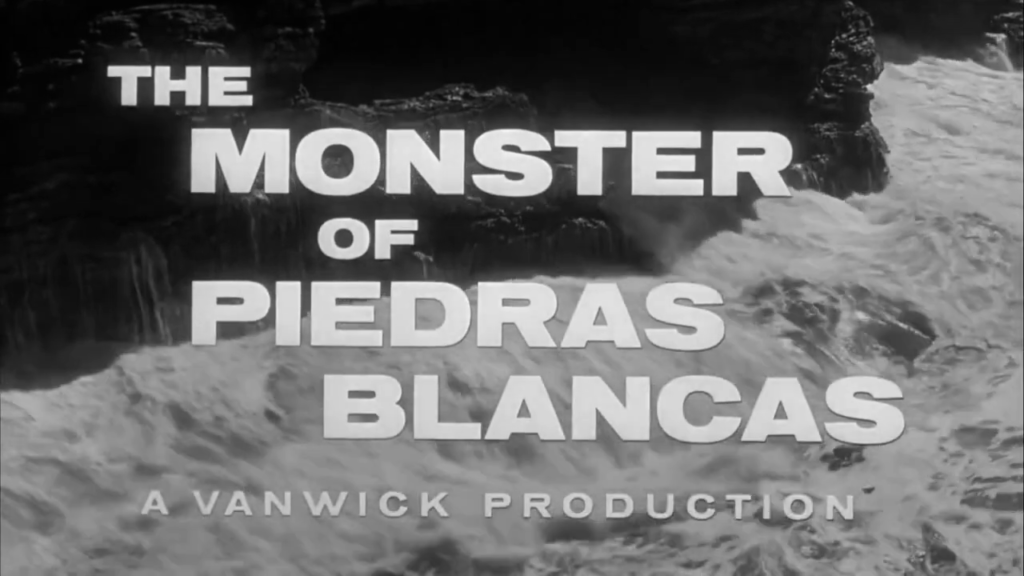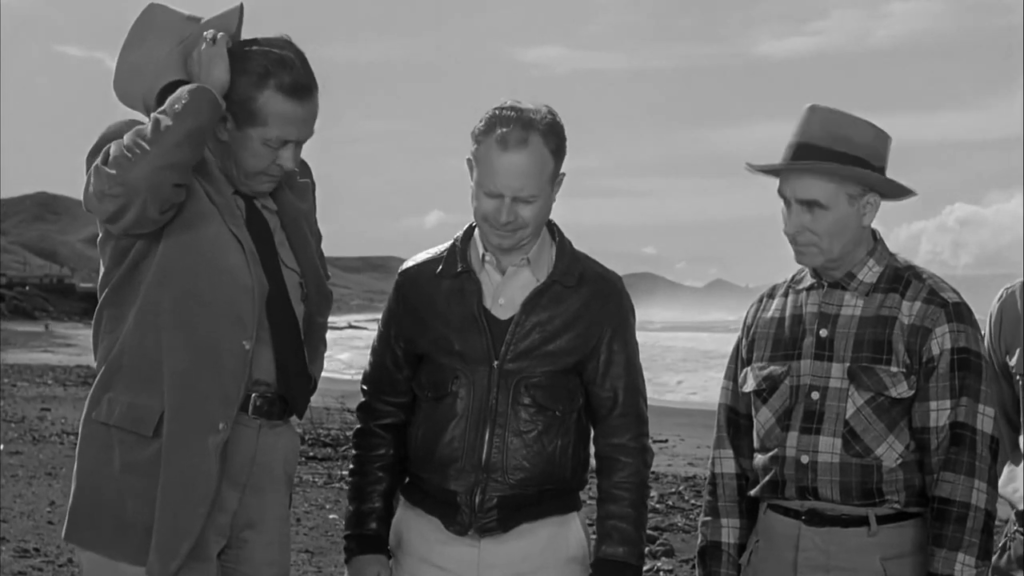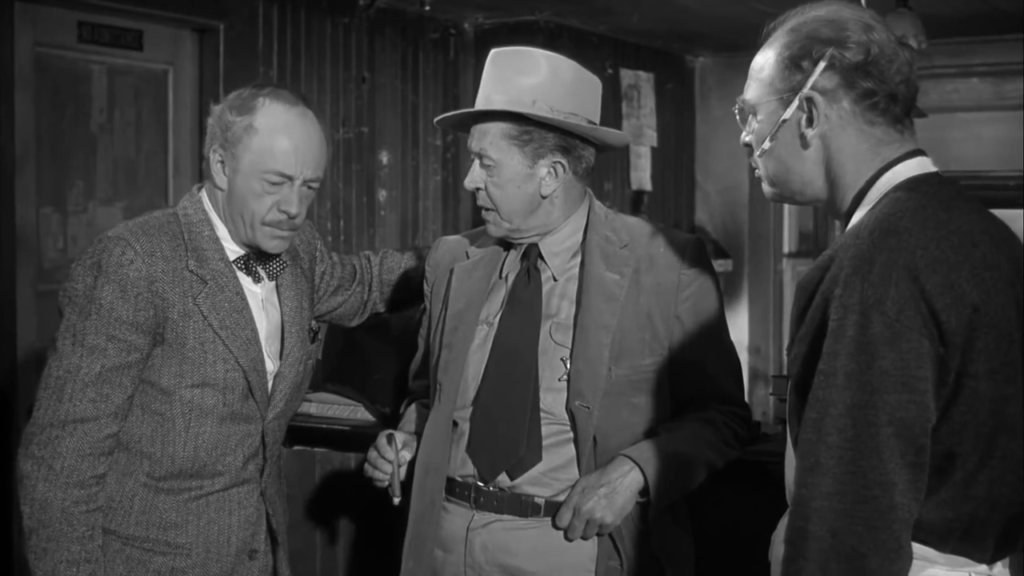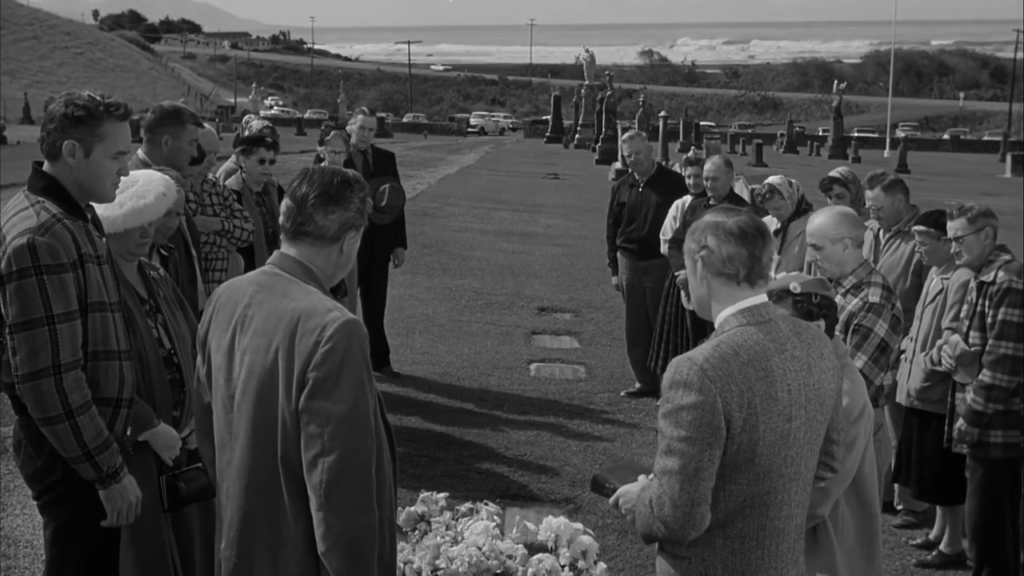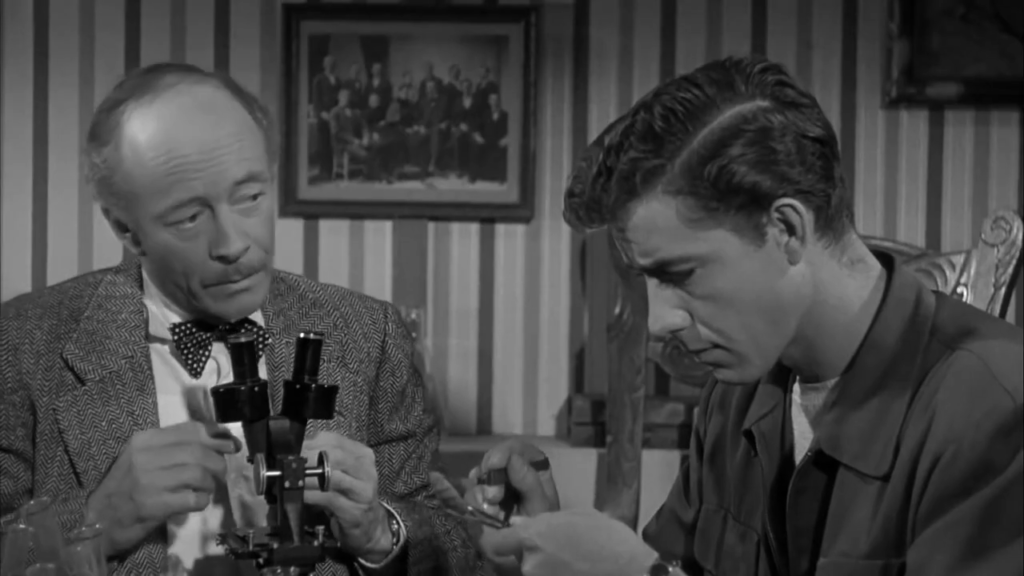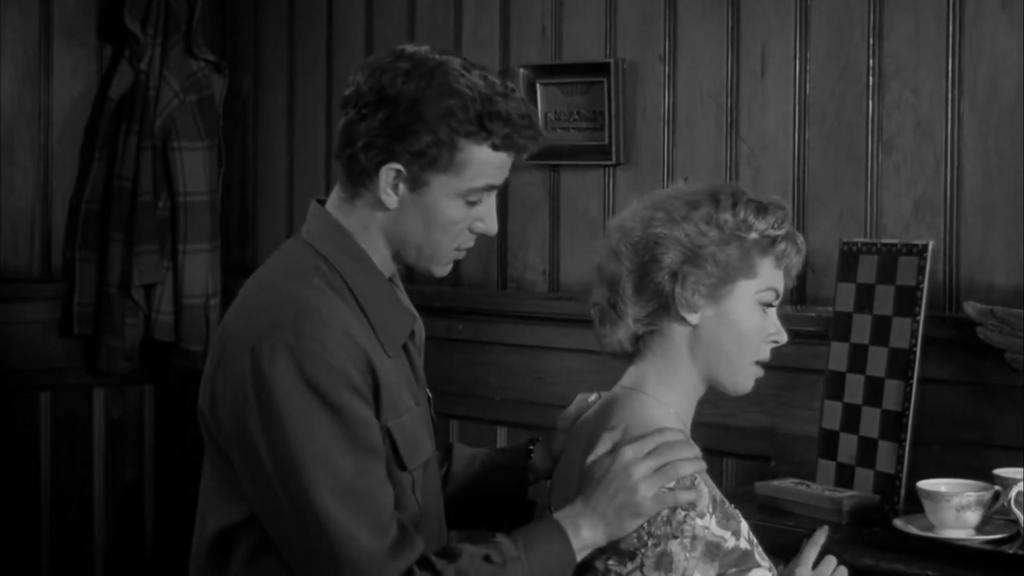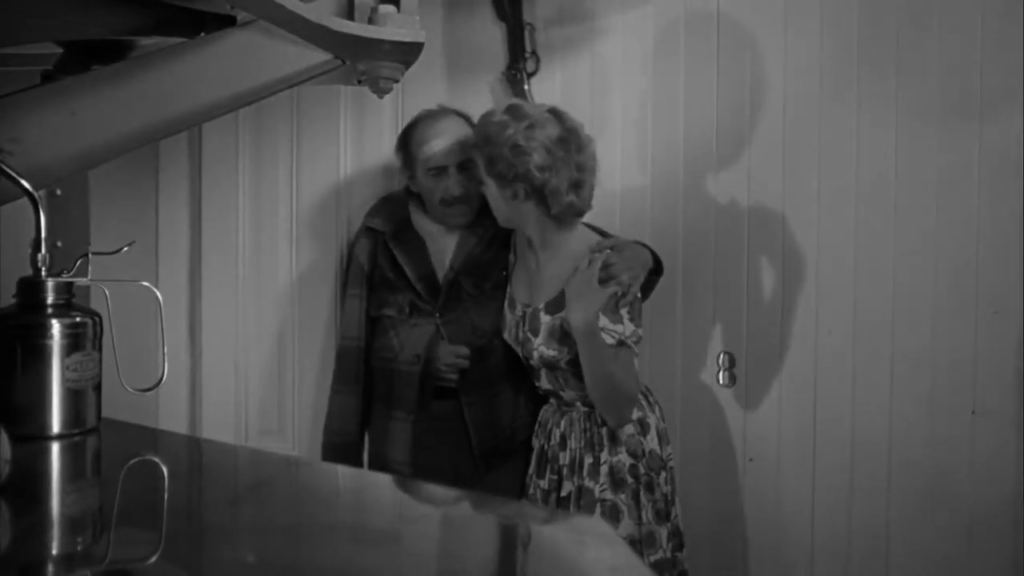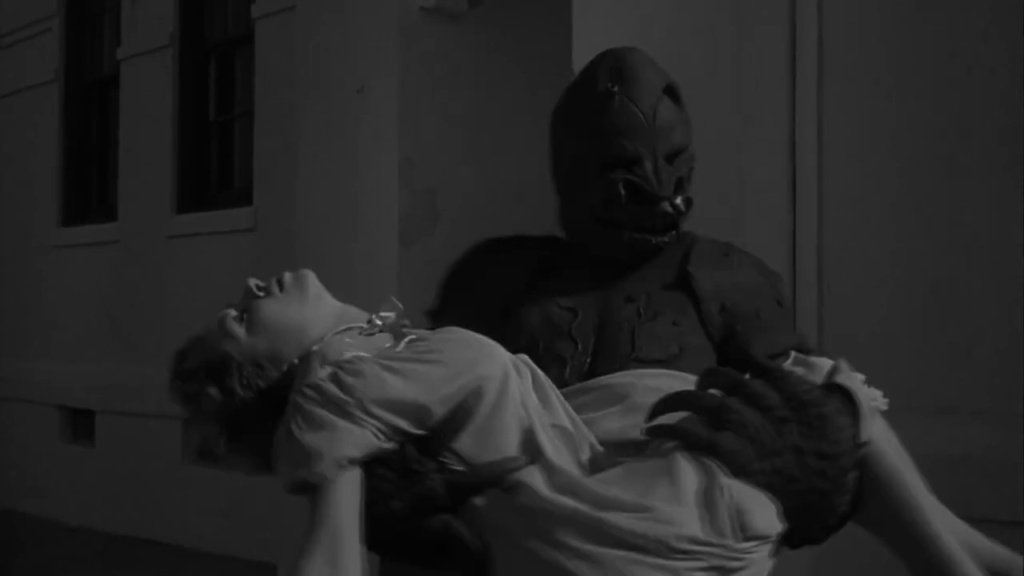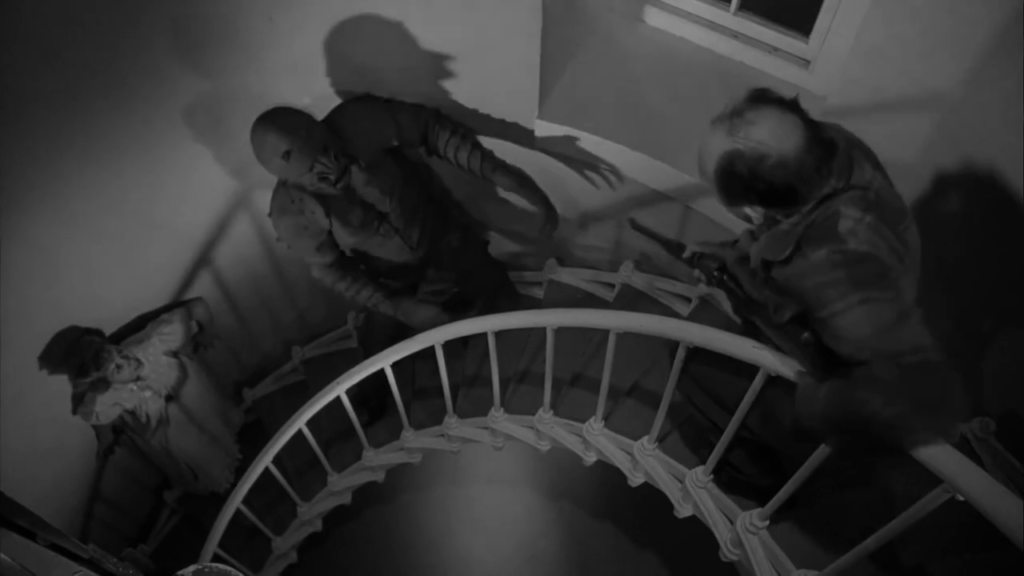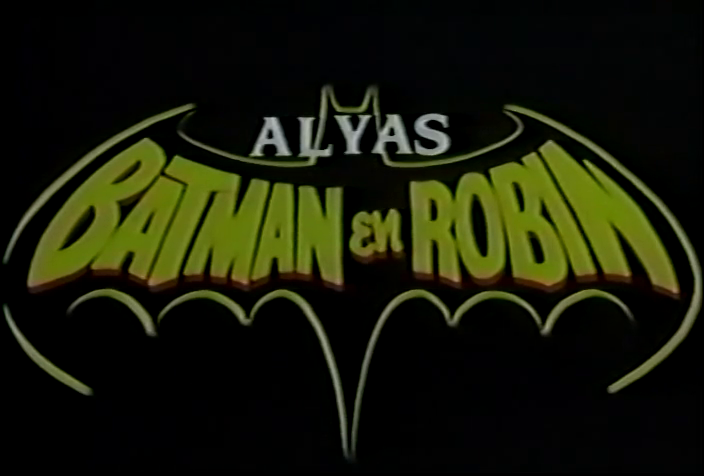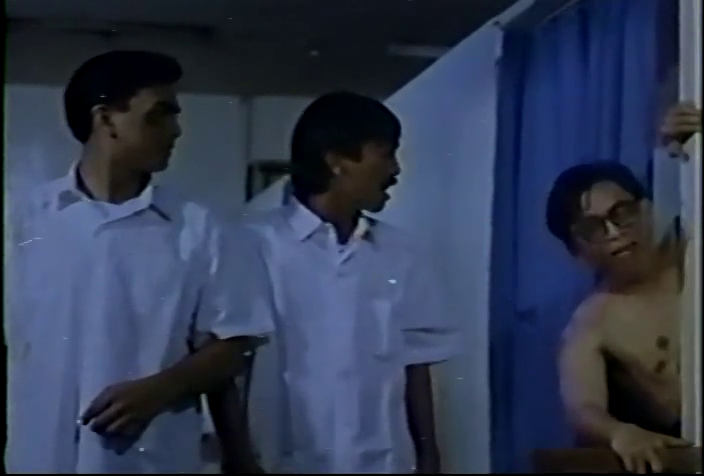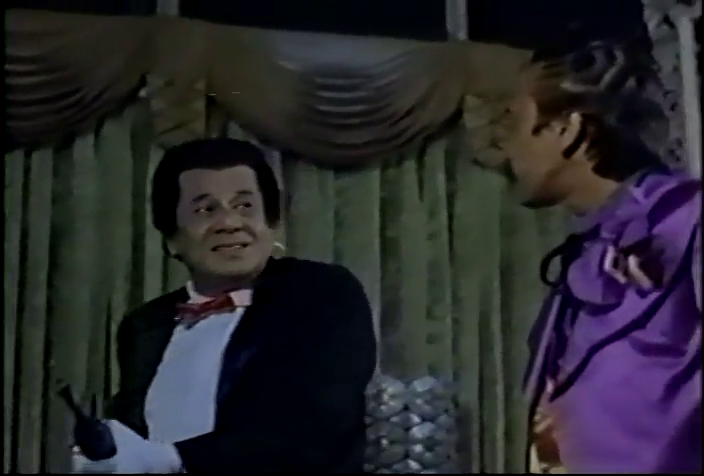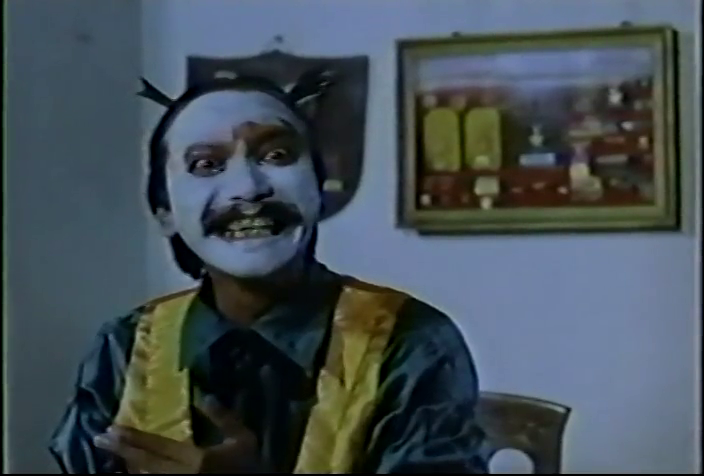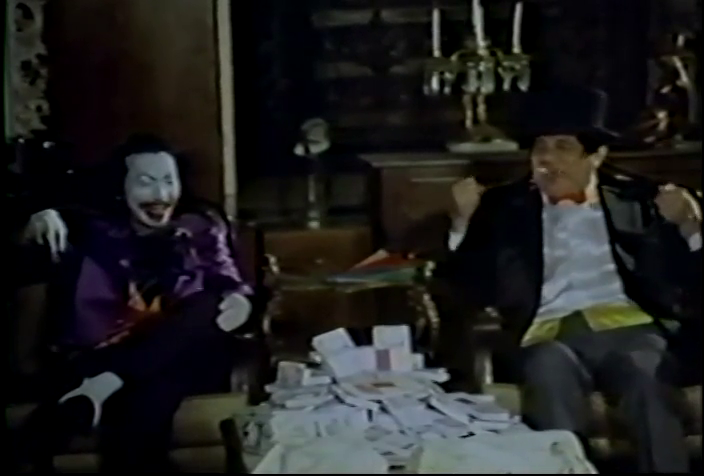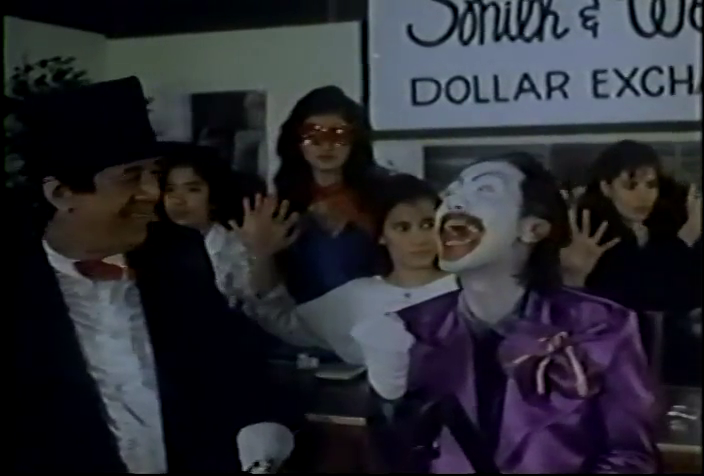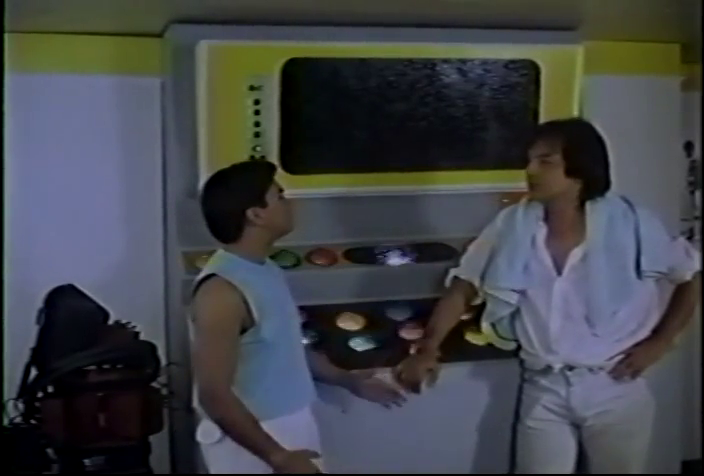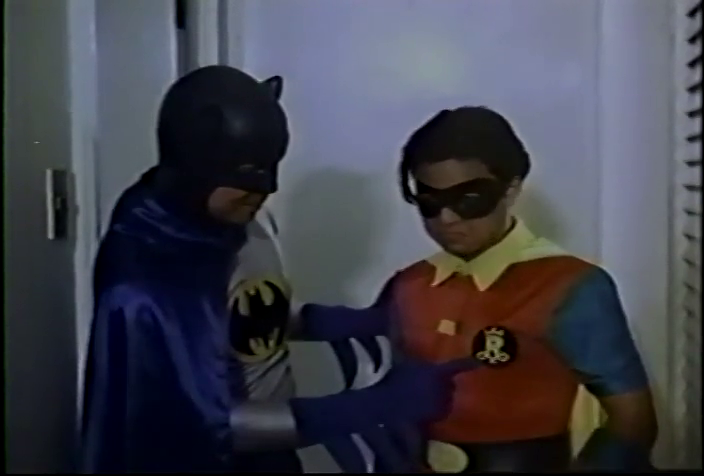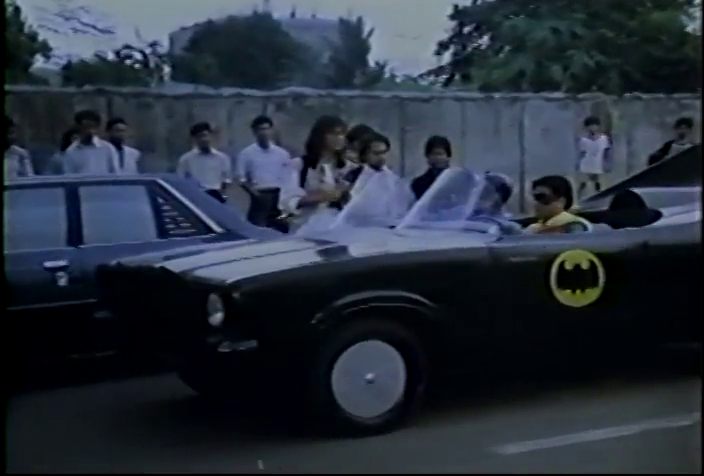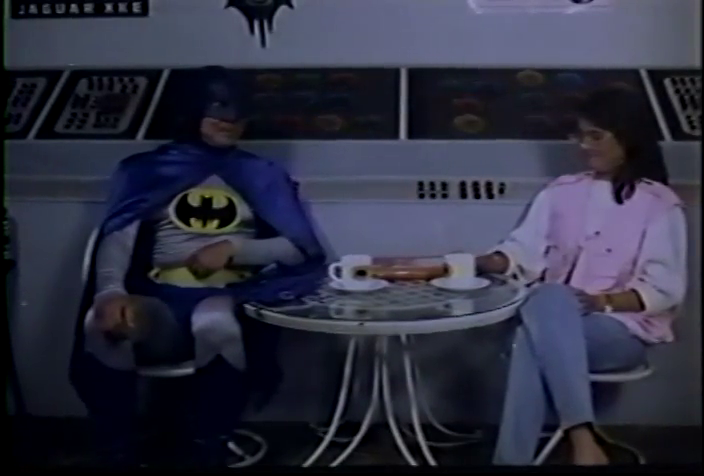-
#491 – The Alligator People (1959)
The Alligator People (1959)
Film review #491
Director: Roy Del Ruth
SYNOPSIS: Newly-wed couple Joyce and Paul Webster are aboard a train on the way to their honeymoon when Paul receives a telegram that disturbs him, causing him to get off at the next stop and vanish, leaving Joyce on her own. She relentlessly pursues any clues about where her husband may have gone, leading her to a plantation in Louisiana, which he once registered as his college address. There, she suspects that there may be some answers to her questions, but everyone seems to think otherwise…
THOUGHTS/ANALYSIS: The Alligator People is a 1959 sci-fi horror film. In the opening, we see nurse Jane Marvin undergoing a treatment to cure her amnesia. While in a sedated state, she recalls to the supervising doctors the plot of the film: Joyce (as she was then known) had just got married, and they were on the train for their honeymoon, when Paul receives a telegram. Paul seems shaken by the contents and gets off the train at the next mail stop and disappears without explanation, leaving his new wife lost and confused about what happened. Joyce spares no effort in tracking him down, but the only clue she is able to find is an address he gave when he enrolled at college for a plantation in Louisiana, and so Joyce heads there to try and get some answers. The story of the film is honestly pretty well done: everything is contained, flows nicely, the twists are decent, and the explanations and justifications for everything that happens make sense. However, it is still a b-movie from a time when these types of films were cranked out en masse, and so it fits into a category in which things are expected to be a bit cheap and unoriginal. It’s executed better than some of the B-movies I’ve seen, but I think the problem is that it’s still not a very interesting setup. The horror element of the film doesn’t really meet expectations, as the “Alligator people” from the title turns out to be just one person, who is fairly humanised so as to not be portrayed as much of a threat.
The female lead provides a more original twist on the b-movie film, and her inquisitiveness and relentless pursuit of answers concerning her husband is one of the strong points of the film. Unfortunately, there are also moments where she becomes a more typical “damsel in distress,” and the film doesn’t seem to know how to break out of these archetype completely, and her character jumps can go between these two poles very suddenly and awkwardly. The rest of the cast have particular roles to play that, again, while they’re nothing special, fulfil their purpose well. There’s no real gaps in the story or characters which would disrupt the viewing experience, which is pretty rare in a b-movie like this.
The “alligator person,” when their face is finally exposed, is a scaly and deformed result of an experiment designed to harness the limb regeneration of alligators and apply it to humans (again, the explanation works pretty well). The makeup is okay, and not too distracting. When he finally transforms fully into an alligator human hybrid, the results are much worse, as it is clearly a guy in an alligator mask. Apart from that, the execution and production of the film are generally good, with the photography and camera setups working well, and scenes having a good level of detail. Overall, The Alligator People is a decently executed film that ties its characters and plot together well. The main problem is that it’s just not that interesting, and in terms of b-movie monsters, it’s just not as memorable or terrifying as others. It’s definitely better than many B-movies I’ve seen, but a bit of a bore.
-
#490 – Artemis 81 (1981)
Artemis 81 (1981)
Film review #490
Director: Alistair Reid
SYNOPSIS: An epic battle for the future of mankind is about to wage between Helith, the angel of light, and Asrael, the angel of death, Novelist Gideon Harlax finds himself caught up in the middle of this struggle, as the world becomes the battlefield…
THOUGHTS/ANALYSIS: Artemis 81 is a 1981 TV movie. The overall story concerns the battle for the future of mankind between the angel of light named Helith, and the angel of death, Asrael. At the centre of it all seems to be Gideon Harlax, an occult novelist who has detached himself from all emotion. This TV film is very slow-paced and meandering: the first act deals very much with exploring the human creative process and dealing with emotions, which as you might expect is a very broad and varied wander through a lot of different subjects. The film definitely requires your full attention to understand what is going on across its three-hour runtime, but even then you might not get the whole picture, as the themes it explores are very subjective and may not directly impact the story. There’s definitely plenty of depth to it’s exploration of its subjects, and it pushes the boundaries of what you might expect something produced in 1981, in terms of its discussion of homosexuality, suicide and sex. All in all, there is a lot going on in this film, and while it is all very deep and powerful, there’s little sense of pacing and being able to produce an overall coherent narrative: part of that is intentional, because it is very much an exploration of the messy thoughts and feelings of people, but the part of it which ties everything into this battle between the two angels never manages to achieve it’s goal I think.
The film starts off focusing on Gwen Meredith, and her chance meeting with famed musician Albrecht von Drachenfels, whom she wishes to play for. She wishes to explore the depths of feeling and expression in her music, but Gideon, her…friend? husband? I honestly couldn’t work it out; his indifference to getting emotionally involved with anything forms a stark contrast with the people around him. We see his discussions with a number of people baring their souls while he remains cold and unmoving, and it works as a setup that allows us to explore the themes the film sets out. The plot of the two angels battling it out is the most interesting aspect, but it’s typically dealt with so abstractly it’s quite difficult to follow. There’s a plot concerning Albrecht and his Mother, and how this relates to the two angels trying to either wake up their Mother or let her sleep, but again it’s left mostly open to interpretation. On a somewhat interesting note, the angel of light is played by Sting in his first big (?) acting role: luckily, his awkward portrayal works pretty well since he’s playing an angel that doesn’t really know how to interact with humans.
Overall, Artemis 81 is a very full-bodied experience that requires your full concentration to grasp both the overall story and the exploration of the issues it raises. The uneven pacing doesn’t help with respect to getting to grips with the content of the film either. The dialogue is extremely unnatural and metaphysical, leaving every conversation feeling like an exercise in philosophical discourse. Despite all of this opacity though, Artemis 81 does have the courage to push some boundaries, and takes the subjects it addresses seriously, and if you have the concentration to watch it uninterrupted for its three hour runtime, then it’s an interesting film of it’s time.
-
#489 – The Monster of Piedra Blancas (1959)
The Monster of Piedras Blancas (1959)
Film review #489
Director: Irvin Berwick
SYNOPSIS: The quiet Californian town of Piedras Blancas hides a dark secret: in the caves beneath the lighthouse, there hides an ancient monster that starts killing the residents of this sleepy town. Unaware of the monster’s existence, a number of the residents try to find out what is causing the killings…
THOUGHTS/ANALYSIS: The Monster of Piedras Blancas is a 1959 sci-fi horror film. Set in the small lighthouse town of Piedras Blancas in Southern California, the residents of the town find themselves being killed off one by one, with no idea who…or what is doing it. The film is paced like a typical monster movie of the time, with very little momentum at the beginning, and various murders until the monster’s reveal. The pacing is very slow in this one, and we only get the reveal of the monster about two-thirds of the way in, and everything before just involves these cast of characters that do little to distinguish themselves. The dialogue is pretty dull, and the character development doesn’t help make things exciting. I suppose this dullness reflects the setting of this sleepy seaside town, but it doesn’t really make for an interesting movie.
The film is an independent production, so it doesn’t have the backing of the big studios, but then again, those same studios were cranking out films like this at about the same quality, and the same runtime just over an hour long (this runtime was typically suitable for being shown at drive-in cinemas as part of double features, that were popular at the time). As such, it’s rather indistinguishable from a more ‘mainstream’ production. The on-location shots of the cliffs and the town do give it a more authentic feel instead of just relying on sets, so it does have that going for it. The cast of characters can easily be remembered by their roles, and their names are somewhat irrelevant: you have the doctor, sheriff, storekeeper, lighthouse keeper and the young couple. Each of them, as mentioned, fills out a fairly predictable role, and adds very little to proceedings. The young woman manages to show a lot of skin fairly regularly (even going swimming in the sea naked at one point), which would have been a little risqué at the time, and not something I’m sure a bigger production could have gotten away with.
The most notable aspect of this film is definitely the monster itself. Very similar in design to “The creature from the black lagoon,” (and designed by the same creator), the monster is based on a diplovertebron, which was a prehistoric creature that lived over three hundred million years ago. We don’t get too many shots of the creature in it’s full glory, but when we do it looks fairly decent for the time, with a scaly skin and water oozing out of its mouth. One of the other most memorable aspects of the film is the use of gore. In most Hollywood films, the killings would be done offscreen or without any blood or viscerality. When we get the full reveal of the monster, he is carrying the bloody decapitated head of his latest victim, which certainly comes as a shock, since nothing else has happened in the film up to that point, and also you just don’t expect to see that kind of gore in these films; also, the effect looks pretty convincing too. We get another shot later on of the abandoned head being walked over by a crab which is also has the same effect, but apart from that, there’s not too much to say about this film. The Monster of Piedras Blancas is a fairly forgettable film save for one or two moments that show off its horror credentials. It’s fairly short runtime means you can probably check it out without too much fuss though.
-
#488 – Alyas Batman en Robin (1991)
Alyas Batman en Robin (1991)
Film review #488
Director: Tony Y. Reyes
SYNOPSIS: Kevin is a comic book obsessed teenager that idolises the heroic exploits of Batman and Robin. When two men dressed as Batman’s enemies The Joker and Penguin, Kevin convinces his brother to dress up as Batman and him as Robin, in order to take on the criminals and bring them to justice…
THOUGHTS/ANALYSIS: Alyas Batman en Robin is a 1991 superhero comedy musical…parody…it’s a lot of things. The film centres around Kevin, a high school student that idolises the comic book adventures of Batman and Robin. His classmate, Jocson, prefers Batman’s nemesis The Joker, and when his uncle Paeng begins to start a crime spree, Jocson convinces him to become the Batman villain The Penguin (calling him the Paenguin), while he adopts the guise of his favourite The Joker. Seeing the reports of these criminal deeds, Kevin convinces his brother Kuya that they should become Batman and Robin to put a stop to the villains, to which Kuya initially reluctantly agrees. The film is basically a parody of the 1960s Batman TV series, which might seem a bit odd because both that the series was already light-hearted and a parody, and also that this film came out in 1991: twenty-five years after the series first started airing. I guess the series is a bit timeless, and there was the fact that the newer, darker Batman films were being released in the West at the time, so it doesn’t come completely out of nowhere. The film is basically just a bunch of setups with the Penguin and Joker doing a crime, and Batman and Robin trying to stop it. It’s fairly simple stuff, and provides a stable enough backdrop for all the other comedy stuff going on. In this regard, it does resemble the Batman film based off the 60s TV series, as that also had a similar setup and pacing. It’s all just a bit of fun, and doesn’t need to be anything more complex. The film is funny when it isn’t trying to be, through it’s low quality and haphazard production, but not too funny when it tries to actually be funny: the fourth wall jokes just come from nowhere, but there’s still a few lines that are somewhat humorous, and the film is generally entertaining in it’s “so bad it’s good” way.
The characters are all fairly standard, and it’s easy to follow who they are. The characters all seem suited to the costumed roles they take up: Kevin is youthful and optimistic like Robin, Kuyo is stoic like Batman, Jocson is eccentric like the Joker, and Paeng is scheming like The Penguin. Everything in terms of characters fits together quite appropriately. Catwoman also turns up, and the end credits features a musical number comprised of of many, many more superheroes, like Superman, Spider-Man, Wonder Woman and more. Why they weren’t used in the film itself is a bit puzzling to me; maybe they wanted to stick to focusing on Batman and Robin, but given how the film is a parody that breaks the fourth wall and has little consideration for logic, it seems odd that it would not use these character in some way, even as punchlines for a joke somewhere.
In case you hadn’t guessed, this is a film that does not have the licence or permission to use any of the characters that star in it. It exists in that strange sub-section of films that could only have been made and released in pre-internet times, when corporations who own these characters could not find these productions and sue them into oblivion. Obviously taking other people’s characters and trademarks isn’t good, but you can still have a soft spot for these blatant parodies that just have a bit of harmless fun with the property. The low budget production does however have some good points: the costumes are pretty accurate to the TV series it is based on, and they are colourful and fit pretty well. The Joker’s costume is pretty good: Jocson’s moustache is used as the Joker’s extended top lip, which is pretty clever. Even the Batmobile looks pretty good. The musical numbers are perhaps one of the stranger aspects of the film, but for the most part, the songs are pretty forgettable. The performances are, however, probably the most memorable parts, as they’re just so ridiculously over-the-top and flamboyant in a way that you would never expect these characters to act, that it’s certainly something you won’t see anywhere else. Overall, Alyas Batman en Robin is a silly bit of fun that is fairly empty in terms of story and production, but there’s enough competency and a willingness to play with the concept and characters that means it is at least entertaining enough to sit through.
